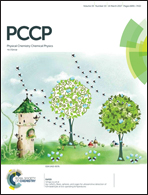How persistent microbubbles shield nanoparticle productivity in laser synthesis of colloids – quantification of their volume, dwell dynamics, and gas composition†
Abstract
During laser synthesis of colloids, cavitation bubbles with lifetimes in the microsecond-scale form and shield the laser pulse leading to a decrease in nanoparticle output. A second type of productivity-limiting bubble that severely affects the productivity of the process is often neglected. With lifetimes from milliseconds to seconds, these persistent bubbles are systematically studied in this work by quantifying their composition, amount, size and dwell time in liquids with different viscosities and by relating the results to the nanoparticle productivities. It is found that during synthesis in water, water splitting occurs leading to persistent bubbles consisting of hydrogen and oxygen. In glycols, hydrogen and molecular carbon species containing microbubbles are formed. These persistent microbubbles shield up to 65% of the incoming laser beam depending on the liquid as well as the laser fluence and require attention by means of reducing their dwell time in the ablation zone and enhancing the nanoparticle output by liquid flow. The highest productivities and monodisperse quality are achieved in liquids with the lowest viscosities.



 Please wait while we load your content...
Please wait while we load your content...